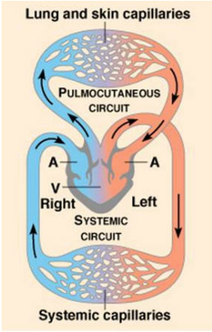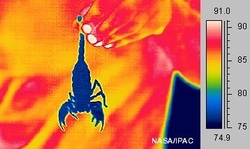Interesting Facts about Red-Eyed Tree Frogs
Red eyed tree frogs are amphibians. This means that they start out as larva and undergo metamorphosis. Another quality that amphibians and tree frogs have is the ability to use their skin as a means of respiration. The main difference between amphibians and similar reptiles is that amphibians require bodies of water in which to breed (1).
Tree frogs use their bright skin colors to fend off predators. Contrary to what their skin color tells us, red eyed tree frogs are not venomous, though their striking appearance makes other hungry animals question the safety of their next snack (1).
Cold Blooded!
Amphibians are 'cold blooded'. This essentially means that cold blooded animals take on the temperature of their surroundings, and aren't able to generate heat or cool themselves down like mammals can. For example, on a hot day, a tree frog can bask on its leaf and soak up energy, overall becoming more active. In cold temperatures, this same frog would become very sluggish (4).
Heart and Blood Flow
One of the main attributes of the frogs' heart is the 3 compartment structure. Frogs have one ventricle and two atria. With only one ventricle there is some mixture of oxygenated and de-oxygenated blood, so fortunately, like humans, have ventricular folds to prevent blood back flow to and from the atria. Blood leaves the heart by the truncus arteriosus where it branches into two aortic arches, each branch then leads to the lungs and skin where oxygenation occurs. Carotid arches also branch off the aortic arches to reach the head region of the frogs body (2).

The flow of blood starts by arriving in the right atrium by the veins from the body.
The left atrium receives the oxygenated blood from the lungs and skin.
Both types of blood are emptied into the one ventricle.
When the ventricle contracts, the oxygenated blood that is relatively pure flows to the carotid arches from the left atrium taking the blood to the head and brain on of the frog.
The de-oxygenated blood from the right atrium heads to the pulmocutaneous arteries, taking the blood to the capillaries of the blood and skin where oxygen can be picked up (3).
Due to the one ventricle structure, the blood in the aortic arches is a mixture of oxygenated and de-oxygenated blood. Even so, the arteries still have enough oxygen content to supply the rest of the body (3).
The left atrium receives the oxygenated blood from the lungs and skin.
Both types of blood are emptied into the one ventricle.
When the ventricle contracts, the oxygenated blood that is relatively pure flows to the carotid arches from the left atrium taking the blood to the head and brain on of the frog.
The de-oxygenated blood from the right atrium heads to the pulmocutaneous arteries, taking the blood to the capillaries of the blood and skin where oxygen can be picked up (3).
Due to the one ventricle structure, the blood in the aortic arches is a mixture of oxygenated and de-oxygenated blood. Even so, the arteries still have enough oxygen content to supply the rest of the body (3).
Research on Red-Eyed Tree Frogs
Tree frogs need a body of water to breed because their eggs are laid on the underside of a leaf, dropping down to water below while hatching as tad poles. A study done by the Department of Zoology, Austin, Texas, tells us that these tad poles have external gills, and once they meet the water they begin to regress within minutes to hours. This study observes the processes of the external gills, and how when exposed to oxygen, regress at a much faster rate even if the egg has not yet fallen to the water. Overall, the exposure to oxygen determines the rate of development of the embryo or tad pole (5).
This research is important to the growth and adaptations of red-eyed tree frogs. While these results were found by the observations of natural processes, the data is not particularly significant in the fact that only other natural processes can determine the states of what is currently the fate for newly laid eggs.
We should care about this data because there is a possibility that the natural habit of tree frogs and their breeding grounds could be diminishing. The science behind the oxidation that occurs to the young offspring could increase, and the development and growth of this species and many others will be in danger.
This research is important to the growth and adaptations of red-eyed tree frogs. While these results were found by the observations of natural processes, the data is not particularly significant in the fact that only other natural processes can determine the states of what is currently the fate for newly laid eggs.
We should care about this data because there is a possibility that the natural habit of tree frogs and their breeding grounds could be diminishing. The science behind the oxidation that occurs to the young offspring could increase, and the development and growth of this species and many others will be in danger.


